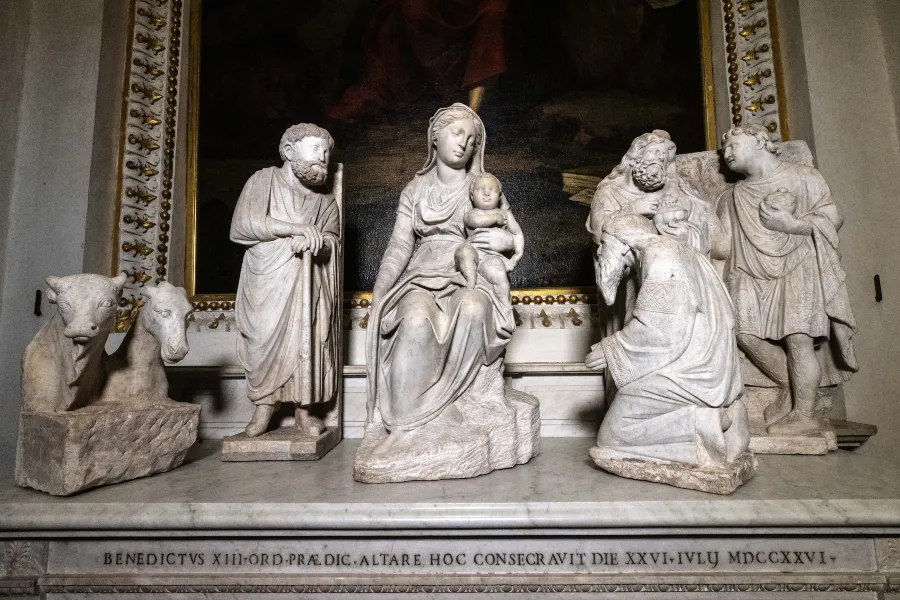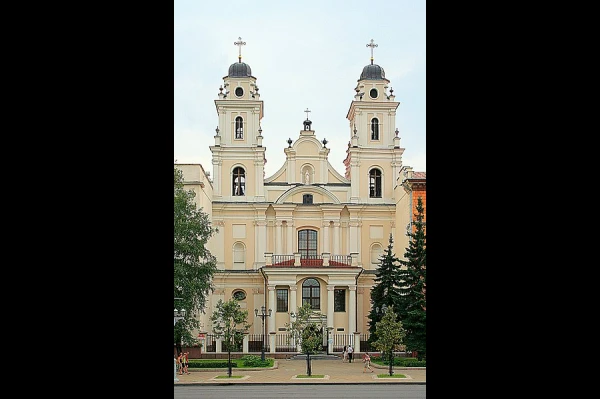
CNA Staff, Dec 14, 2023 / 17:15 pm (CNA).
Pope Francis said this week that a “place is already prepared” for him to be buried at the Basilica of St. Mary Major, and not — as has been the custom of popes for over a century — at the Vatican.
With roots stretching back to the fifth century, St. Mary Major (called Santa Maria Maggiore in Italian and sometimes referred to as Our Lady of the Snows) is one of the most famous Catholic churches in the world and one of the four “major basilicas” located in and around Rome.
Pope Francis has made more than 100 visits to the basilica since becoming pope, most notably to venerate the icon known as the “Salus Populi Romani” — “Mary, Protection of the Roman People” — before and after every international trip.
Here’s a look at the tombs of the six popes who are buried at this church, one of whom is a saint. (Information on each pope comes from the 1917 Catholic Encyclopedia unless otherwise noted.)
Pope Honorius III (1150–1227)
Born Cencio Savelli, Honorius III was the first pope to be buried here after his death in the 13th century. He served as part of a chapter of priests who helped to administer St. Mary Major before becoming pope and held other important positions before his election.
Honorius III is perhaps most notable for having confirmed St. Francis’ second “rule” — a plan of life and discipline — for the saint’s then-new religious order. Innocent III had first approved a simple rule for the new order in 1209, but the “second rule,” approved by Honorius in 1223, is the one that Franciscans still profess today.
Pope Nicholas IV (1227–1292)
Girolamo Masci was elected pope in 1288, the first Franciscan to hold the office. As pope, he sent missionaries to Bulgaria, Ethiopia, China, and the Tartar people of Central Asia. He built the palace next to St. Mary Major, the church that was to become his final resting place.
In 1292, Nicholas IV commissioned the first known Nativity scene figurines, inspired by St. Francis of Assisi, the creator of the first living Nativity in Greccio, Italy, in 1223.

St. Pius V (1504-1572)
The only saintly pope to be buried here — though not the only saint — Pius V was born Michele Ghislieri in 1504 to poor parents of noble lineage. He was a Dominican known for his austere penances and long hours of prayer and fasting. He was elected pope on Jan. 7, 1566, with the influential backing of his friend St. Charles Borromeo.

His pontificate was dedicated to applying the reforms of the Council of Trent, which took place from 1545–63 in response to the Protestant Reformation. As pope he set about raising the standard of morality of the Catholic clergy and strongly supported foreign missions. The Catechism of the Council of Trent was completed during his reign.
Ironically, Pius V promulgated a new Roman Missal in 1570 that is still used today as part of the Tridentine Mass, also known as the Traditional Latin Mass — the celebration of which Pope Francis has moved to curtail throughout his papacy in favor of Pope Paul VI’s 1970 missal.
A devotee to Mary, Pius V established the feast of Our Lady of the Rosary, which is celebrated each year on Oct. 7.
Pope Sixtus V (1521–1590)

Few popes had as much of an effect on the city of Rome itself as Felice Peretti, Pope Sixtus V. In addition to reforming the Church’s finances, he made far-reaching changes to the Church’s governing structure. He is perhaps best known for his massive public works projects throughout Rome, including the building of magnificent streets and the moving of a massive obelisk into the center of St. Peter’s Square. He also built the Chapel of the Cradle, which is said to contain relics of Jesus’ manger, at St. Mary Major.
Pope Clement VIII (1536–1605)

Ippolito Aldobrandini was elected pope in 1592. St. Philip Neri was reportedly his confessor for 30 years.
Known for his reforms amid major contemporary geopolitical problems, Clement VIII also issued revised editions of the Latin Vulgate Bible in 1598, and also new editions of the Church’s breviary and missal.
Pope Clement IX (1600–1669)

Clement IX, born Giulio Rospigliosi, is the most recent pope to be buried at St. Mary Major, having been laid to rest there more than 350 years ago. Clement requested that he be buried at St. Mary Major with merely a simple inscription, but his successor erected a large statue and monument to him inside the church.
After his election as pope, Clement reportedly manned a confessional at St. Peter’s Basilica two days a week and heard anyone who wished to confess to him. He frequently visited hospitals, was lavish in his alms to the poor, and resisted the then-widespread practice of nepotism.
He is perhaps most notable for declaring St. Rose of Lima a Blessed in 1668, and she would go on to become the first saint from the Americas.
If you value the news and views Catholic World Report provides, please consider donating to support our efforts. Your contribution will help us continue to make CWR available to all readers worldwide for free, without a subscription. Thank you for your generosity!
Click here for more information on donating to CWR. Click here to sign up for our newsletter.





His Holiness Pope Francis is doing fine. His best is yet to come. God bless.
What is “fine” about his obsessive denigration of God’s Deposit of Faith?
There goes the neighbourhood….great men of faith…
An admirable proposal leaving us with serious afterthought. Ruminations of distressful realities, their meaning for each of us personally and for the Church. Whether we’re to be left with a Church in ruins, in store for further pain with a Pope Francis disciple at the reins.
Reality one is that we don’t know whether this is the end, or the beginning. Many of us muse about His Holiness’ person. At that, we don’t really know. At times a lovable old man hugging the wounded, or calling his perceived enemies eaters of excretion. Card Raymond Burke an ‘enemy’ who prays for Francis, who believes he’s doing Francis brotherly justice. Burke, who alleges apostasy within the Church. It’s clear he’s referring to His Holiness among others.
Our dilemma is Francis’ message is compelling. A powerful appeal to open the doors to the morally wounded to enter a statistically dying Church for at least a chance of redemption. What is there to lose when the Church is losing countless members in Germany and elsewhere? What is there to gain if not the souls of the lost? Burke would argue we can’t obey Christ if omit conversion and repentance as a condition for entry. Francis will counter that we offer the disenfranchised divorced and remarried, homosexuals a lifeline. Amoris Laetitia expresses it well. When does rigid justice soften with mercy? After all, the hypothetical solution is the only real one.
Card Gerhard Muller recently identified the ambiguity in Amoris and the Argentine
papal letters deposited in the AAS. It goes beyond that oblique magisterial ‘teaching’ to the disintegration attributed to Francis of those principles, conscience, revelation, principles of moral justice that form certitude, that is, reasonable certitude. We may never achieve absolute certitude when discussing transient conditions. What we must acknowledge is reasonable certitude such as manifest adultery, manifest disordered sexual behavior. Otherwise we can never justifiably distinguish good from evil. We may not say with certitude who and what Francis portends in the schema of things eschatological. We can say in agreement with Card Burke that apostasy is a condition for eschatology.
Six popes are buried at St. Mary Major; Pope Francis says he’ll be next
An admirable proposal leaving us with serious afterthought. Ruminations of distressful realities, their meaning for each of us personally and for the Church. Whether we’re to be left with a Church in ruins, in store for further pain with a Pope Francis disciple at the reins.
Reality one is that we don’t know whether this is the end, or the beginning. Many of us muse about His Holiness’ person. At that, we don’t really know. At times a lovable old man hugging the wounded, or rebuking his perceived enemies. Card Raymond Burke a perceived enemy who prays for Francis, who believes he’s doing Francis brotherly justice. Burke, who alleges apostasy within the Church.
Our dilemma is Francis ‘ message is compelling. A powerful appeal to open the doors to the morally wounded to enter a statistically dying Church for at least a chance of redemption. What is there to lose when the Church is losing countless members in Germany and elsewhere? What is there to gain if not the souls of the lost? Burke would argue we can’t obey Christ if omit conversion and repentance as a condition for entry. Francis will counter that we offer the disenfranchised divorced and remarried, homosexuals a lifeline. Amoris Laetitia expresses it well. When does rigid justice soften with mercy? After all, the hypothetical solution is the only real one.
Card Gerhard Muller recently identified the ambiguity in Amoris and the Argentine papal letters deposited in the AAS. It goes beyond that oblique magisterial ‘teaching’ to the disintegration attributed to Francis of those principles, conscience, revelation, principles of moral justice that form certitude, that is, reasonable certitude. We may never achieve absolute certitude when discussing transient conditions. What we must acknowledge is reasonable certitude such as manifest adultery, manifest disordered sexual behavior. Otherwise we can never justifiably distinguish good from evil.
We may not say with certitude who and what Francis portends in the schema of things eschatological. We can say in agreement with Card Burke that apostasy is a condition for eschatology.
We’ve always had an ‘open border’ policy for entering the doors of a Catholic church. No interrogators at the entrance. Neither do priests question communicants, even when known sinners since we don’t know their state of conscience. Only when a public figure known for their defiance of requisite Church doctrine. Or homosexuals with their peculiar attire.
So what is Pope Francis getting at, at least what does his message convey if not an open door policy to enter the Church and receive the sacraments for the doctrinally non compliant? An invitation as you are, apparently even if absent of the desire to convert their life in compliance with the Church, Christ’s Mystical Body.
While decrying moralism they are saying it is moral!
Or, they say you are looking back “always done this way” but then they lay claim to sensus fidelium!
Or the spirit of the air told them to move around the furniture and the air to intensify the spirit!
Or they are exposed merely by analogy or allegory etc. and they moan that it’s casuistry!
Or, old soured wine in new casks!
Yes Elias the contradictions abound.
I might be a contradiction I can admit but desperations claiming to be dissolved in presumptions can’t lead deeper conversion.